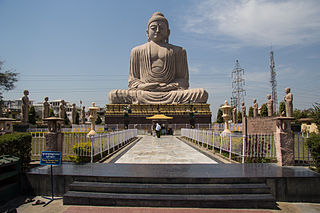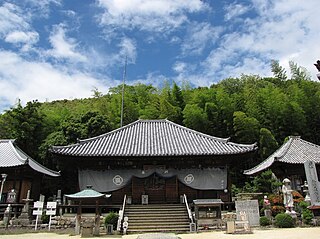
Oizuru is one of the sacred garments of the traditional dress of Japanese pilgrims.

Oizuru is one of the sacred garments of the traditional dress of Japanese pilgrims.
Oizuru is the one of essentials of the Pilgrims. It is a simple outer garment. The shape of the garment is similar to a white coat or a jacket. There are three breadths of material are used in it that signify the Buddhist deities (Amida, Kwannon, and Seishi). The garment is stamped with a seal pilgrims visit. It is then preserved with utmost care. They clad the owner in the same at the time of burial. [1] [2] [3] [4]

Shikoku is one of the five main islands of Japan. Shikoku is the second-smallest main island after Okinawa. It is 225 km or 139.8 mi long and between 50 and 150 km or 31.1 and 93.2 mi wide. It has a population of 3.8 million. It is south of Honshu and northeast of Kyushu. Shikoku's ancient names include Iyo-no-futana-shima (伊予之二名島), Iyo-shima (伊予島), and Futana-shima (二名島), and its current name refers to the four former provinces that made up the island: Awa, Tosa, Sanuki, and Iyo.

Mount Kōya is a large temple settlement in Wakayama Prefecture, Japan to the south of Osaka. In the strictest sense, Mount Kōya is the mountain name (sangō) of Kongōbu-ji Temple, the ecclesiastical headquarters of the Koyasan sect of Shingon Buddhism.
Junrei (巡礼) is the word most commonly used for either of two major types of pilgrimages in Japan, in accordance with Buddhism or Shinto. These pilgrimages can be made as a visit to a group of temples, shrines, or other holy sites, in a particular order, often in a circuit of 33 or 88 sites. Other pilgrimages may center on a pilgrimage to a single site. One of the most popular pilgrimages for Buddhists in Japan is visiting the 88 temples on Shikoku.

The Shikoku Pilgrimage or Shikoku Junrei (四国巡礼) is a multi-site pilgrimage of 88 temples associated with the Buddhist monk Kūkai on the island of Shikoku, Japan. A popular and distinctive feature of the island's cultural landscape, and with a long history, large numbers of pilgrims, known as henro (遍路), still undertake the journey for a variety of ascetic, pious, and tourism-related purposes. The pilgrimage is traditionally completed on foot, but modern pilgrims use cars, taxis, buses, bicycles, or motorcycles. The standard walking course is approximately 1,200 kilometres (750 mi) long and can take anywhere from 30 to 60 days to complete.

A religious habit is a distinctive set of religious clothing worn by members of a religious order. Traditionally some plain garb recognizable as a religious habit has also been worn by those leading the religious eremitic and anchoritic life, although in their case without conformity to a particular uniform style.

Sivagiri is an area in Varkala municipality of Trivandrum District in Kerala. It is a pilgrimage centre of Varkala Town where the tomb or samadhi of Sree Narayana Guru is situated. The area is also the place where Guru build the Sarada Temple dedicated to Sarada Devi the goddess of knowledge. His tomb attracts thousands of devotees every year during the Sivagiri Pilgrimage days, from 30 December to 1 January.

The most important places in Buddhism are located in the Gangetic plains of Northern India and Southern Nepal, in the area between New Delhi and Rajgir. This is the area where Gautama Buddha lived and taught, and the main sites connected to his life are now important places of pilgrimage for both Buddhists and Hindus. However, many countries that are or were predominantly Buddhist have shrines and places which can be visited as a pilgrimage.

A shuin is a seal stamp given to worshippers and visitors to Shinto shrines and Buddhist temples in Japan. The seal stamps are often collected in books called shuinchō (朱印帳) that are sold at shrines and temples.

Jōe is a garment worn in Japan by people attending religious ceremonies and activities, including Buddhist and Shinto related occasions. The jōe is essentially a white kariginu, traditional hunting robes worn by nobles during the Heian period.

In religion and spirituality, a pilgrimage is a long journey or search of great moral significance. Sometimes, it is a journey to a sacred place or to a shrine of importance to a person's beliefs and faith. Members of every major religion participate in pilgrimages. A person who makes such a journey is called a pilgrim.
The Saigoku Kannon Pilgrimage is a pilgrimage of thirty-three Buddhist temples throughout the Kansai region of Japan, similar to the Shikoku Pilgrimage. In addition to the official thirty-three temples, there are an additional three known as bangai (番外). The principal image in each temple is Kannon, known to Westerners as the Bodhisattva of Compassion ; however, there is some variation among the images and the powers they possess.
The Bandō Sanjūsankasho (坂東三十三箇所) is a series of 33 Buddhist temples in Eastern Japan sacred to Goddess Kannon. Bandō is the old name for what is now the Kantō region, used in this case because the temples are all in the Prefectures of Kanagawa, Saitama, Tokyo, Gunma, Ibaraki, Tochigi and Chiba. As is the case with all such circuits, each location has a rank, and pilgrims believe that visiting them all in order is an act of great religious merit.

The Culture of Uttar Pradesh is an Indian Culture which has its roots in the Hindi and Urdu literature, music, fine arts, drama and cinema. Lucknow, the capital of Uttar Pradesh, has several beautiful historical monuments such as Bara Imambara and Chhota Imambara. It has also preserved the damaged complex of the Oudh-period British Resident's quarters, which are being restored.

Tōnohama Station is a railway station on the Asa Line in Yasuda, Aki District, Kōchi Prefecture, Japan. It is operated by the third-sector Tosa Kuroshio Railway with the station number "GN24".

The Byōbuura Gogakusan Tanjō-in Zentsū-ji (屏風浦五岳山誕生院善通寺) is a Buddhist temple of the Shingon sect in Zentsūji, Kagawa, Japan. It was established in 807 by Kūkai, founder of Shingon Buddhism, who was born where the temple now stands. The oldest structure, the Shakadō Hall, dates to around 1677.

Jōdo-ji (浄土寺) is a Shingon temple in Matsuyama, Japan. It is Temple 49 on the Shikoku 88 temple pilgrimage, and temple two on The Thirteen Buddhist Sites of Iyo.

Ōkubo-ji (大窪寺) is a Shingon temple in Sanuki, Kagawa Prefecture, Japan. It is Temple 88 on the Shikoku 88 temple pilgrimage. Pilgrims leave their kongō-zue at the temple when completing the circuit. The Ōkubo-ji temple bell and pilgrim bells have been selected by the Ministry of the Environment as one of the 100 Soundscapes of Japan.

The kongō-zue or kongō-jō is a wooden staff carried by yamabushi and pilgrims on the Shikoku Pilgrimage in Japan. The kongō-zue is said to represent the body of Kūkai and to support the pilgrim along the way; as such it is treated with respect, having its "feet" washed and being brought inside at the end of each day's journey. It is inscribed with the chant Namu-Daishi-Henjō-Kongō and Dōgyō-Ninin or "We two pilgrims together". By another tradition it is carried aloft when crossing a bridge so that it does not touch the ground and wake Kōbō Daishi. Pilgrims leave their kongō-zue at Ōkubo-ji, the final temple, upon completion of the circuit. There is an occasional funerary practice in Shikoku and other parts of Japan whereby the decedent is dressed as a pilgrim and placed in the casket along with a staff and pilgrim's stamp book (nōkyōchō) for their final journey.

Ryōzen-ji (霊山寺) is a Kōya-san Shingon temple in Naruto, Tokushima Prefecture, Japan. Temple 1 of the Shikoku 88 temple pilgrimage, the main image is of Shaka Nyorai. Said to have been founded by Gyōki during the Tempyō era, its buildings are more recent replacements after damage by fires. Located close to the crossing point for pilgrims from the Kansai region, Yūben Shinnen identified the temple as No.1 in his Shikoku henro michishirube of 1687 and subsequent guidebooks followed suit. It is customary to return to Ryōzen-ji as an orei mairi or thanksgiving visit upon completing the pilgrimage, although this may be a relatively recent development.

Emon Saburō (衛門三郎) is a legendary figure of early ninth-century Japan associated with Kūkai and the Shikoku 88 temple pilgrimage.